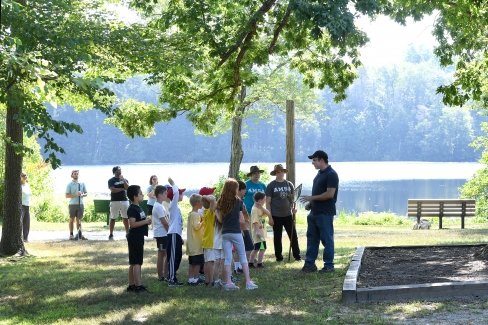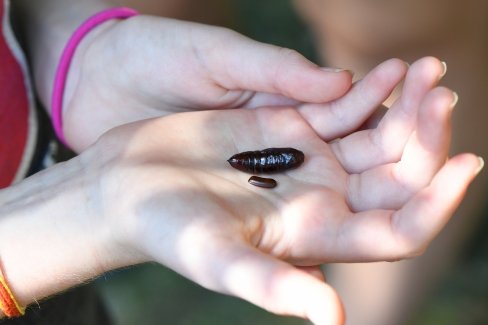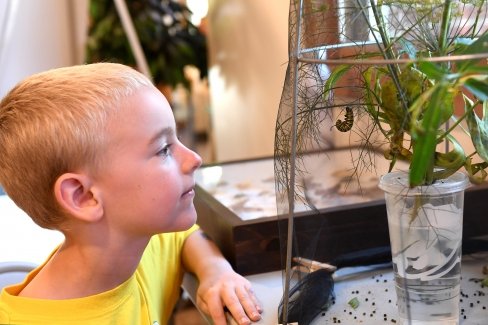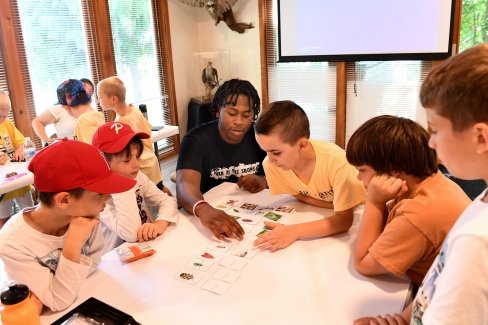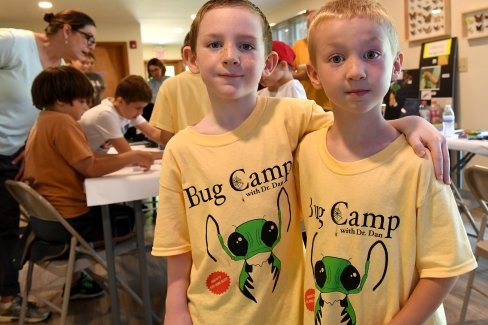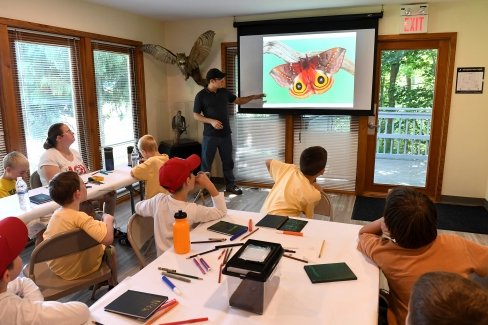Welcome to Bug Camp, with Dr. Dan
Welcome to Bug Camp, with Dr. Dan
Among Dr. Dan’s first lessons at Bug Camp: do not swat stinging insects down upon yourself.
“That’s a sure way to get stung,” explained Dan Duran, a Rowan University entomologist in the School of Earth & Environment and a renowned expert on the fierce group of insects known as tiger beetles.
Demonstrating a sweeping technique instead to about a dozen Bug Campers at Scotland Run Park in Clayton, where he also serves as naturalist, Duran said to avoid getting stung, it’s better to brush critters off of one’s skin.
The lesson was one of many Duran imparted to about a dozen elementary school-age students taking part in Rowan’s first Bug Camp this summer, a program that explored all sorts of flying, floating, hanging, darting, buzzing (but hopefully not stinging) South Jersey insects.
Which wasn’t to say there were none.
Early on the second day of Bug Camp, students clustered about the base of a huge tree near the 80-acre Wilson Lake to view the comings and goings of some European hornets. Glossy and beautiful, almost Rowan-colored in their segmented shells of gold, brown and black, the hornets were about an inch in length and one quarter of an inch wide with glassy, tan wings.
The aggressive, non-native insects had worked their way under the tree’s bark and appeared to be feasting on a sap stream, or tinier critters attracted to it.
“Beware of them,” Duran instructed. “It’s an extremely aggressive, invasive species.”
The hornets stung no campers but their surprise discovery prompted an inevitable round of questions about bug stings.
“What’s the most painful sting?” wondered Steven Harker, 7, from Franklinville.
“Possibly a bullet ant,” Duran replied.
“And what’s the worst you’ve been stung by?”
“Possibly a cow killer.”
Duran went on to explain that cow killers – large, red and black wingless wasps that resemble large ants – are native to South Jersey but said they’re not aggressive and will not sting a human unless provoked. Though their sting is extremely painful, their venom is not especially dangerous and they cannot, despite the fearsome name, kill a cow.
“If you ever come across one, leave it alone and it won’t bother you,” Duran instructed. “And don’t pick it up.”
Most observed insects were harmless
By far, the majority of critters observed during the camp July 29-Aug. 1 were benign, complex creatures doing their best to survive in an ecosystem teeming with life.
Campers dipped nets into Wilson Lake to collect snails, water bugs, even tiny, non-biting water scorpions and dragonfly larvae.
“Dragonfly larvae can live in the water up to four years before they emerge as a dragonfly,” explained Teresa Brown, a Rowan biology and environmental science major who also works as a field technician at Scotland Run Park.
Deeply engrossed – but not grossed out – Laela McGraw, 10, of Media, Pa., proclaimed that she “loves bugs.”
“I’ve loved them since I was young,” she said. “My dad’s a wildlife biologist but I’d love bugs even if he wasn’t.”
Walking about with a cocoon and a cockroach egg sac in the palm of her hand, Laela said she might bring her newfound treasures home.
“You may not want to bring that cockroach sac home,” Duran advised.
The camp featured outdoor lessons – because that’s where the bugs are – as well as indoor instruction and entertainment.
Taking a break from the mid-summer heat, the students convened in the park’s air-conditioned nature center where Duran gave a slideshow lesson on insect camouflage.
“Why are some so hard to see?” he inquired.
“Because they blend in,” Steven Harker replied.
“That’s right,” Duran affirmed. “They blend in for protection because if a predator can’t see them, it can’t eat them.”
He said he started the bug camp to not only provide an interesting, natural experience for young students, but to teach them that insects are crucial to life on earth. Among their many benefits, they aerate soil, pollinate blossoms, control pests and, especially in the case of beetles, feed on dead animals and fallen plants, returning nutrients to the soil.
“Without insects,” Duran said, “our lives would be impossible.”
